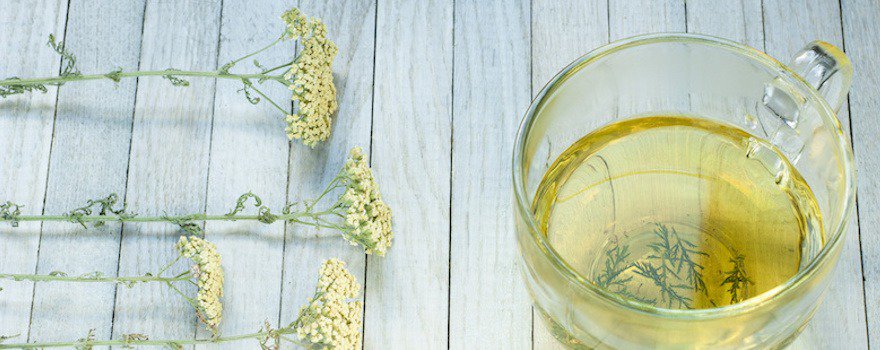BENEFITS OF YARROW
✓ Relieves menstrual pain
✓ Regulates the menstrual cycle and flow
✓ Relieves digestive disorders
✓ Protects the liver
✓ Improves venous disorders
What is yarrow?
Yarrow gets its common name from the Latin Achillea millefolium in reference to Achilles, the legendary hero of the Trojan War. According to the legend recounted in the Natural History of Pliny the Elder, he reportedly used the plant to treat his wounds and promote healing.
Its hemostatic action (which allows bleeding to stop) has in fact earned it many nicknames such as ‘herb for cuts’, ‘bloodletting herb’, or ‘nose-bleed’.
Yarrow belongs to the Asteraceae family, which includes a multitude of herbaceous plants such as wormwood, chamomile, dandelion, and chicory. The genus Achillea comprises 13 different species, the best known of which is Achillea millefolium.
In the wild, the plant grows in the temperate regions of Europe, Asia, and also North and South America. It is frequently found along roadsides, in meadows, and in rather dry habitats.
L’achillée peut mesurer jusqu’à 80 cm de hauteur et possède une multitude de feuilles découpées (d’où son nom latin « millefolium » qui signifie « aux milles feuilles »). Entre juin et septembre, elle produit de petites « fleurs » blanches, appelées capitules, au cœur jaune.

Today, yarrow is also cultivated in gardens for its beauty and medicinal properties. It is the leaves and flowering tops that contain the most active constituents and are used in herbal medicine.
Yarrow is offered as a dietary supplement in the form of capsules, powder, dried aerial parts, or mother tincture. The plant is mainly recommended to relieve gynecological, venous, liver, and digestive disorders.
Nutritional composition
- Minéraux et oligo-éléments : phosphore, potassium
- Sesquiterpènes : guaianolides, germacranolides, eudesmanolides
- Flavonoïdes : lutéolol, apigénine, quercétine, rutine, vitexine, vicénine…
- Alcaloïdes : bétonicine, achilléine, choline, stachydrine, homostachydrine
- Alkamides
- Tanins
- Acides : acides ascorbiques, caféiques, foliques, salicyliques, succiniques
- Coumarines
- Huiles essentielles : eucalyptol, azulène, camphre, chamazulène
- Composés amers : lactones sesquiterpéniques
- Résine

The benefits of yarrow
🌺 Relieves menstrual pain
Along with lady’s mantle (Alchemilla) and the chaste tree (Vitex agnus-castus), yarrow is one of the most useful plants for relieving menstrual pain or dysmenorrhea. Because of its emmenagogue action (stimulates blood flow), its blood‑fluidizing and antispasmodic effects, it facilitates menstrual flow and prevents uterine cramps.
This action is due to flavonoids and especially to luteolol. In addition to being antioxidant and anti-inflammatory, this compound is antispasmodic and analgesic. It notably acts on pelvic pain felt in the lower abdomen.
It may be recommended notably for women suffering from endometriosis.
This study from Islamic Azad University (Iran), conducted on women with primary dysmenorrhea, shows how yarrow helped relieve the pain.
🌺 Regulates the menstrual cycle and flow
Yarrow is also a regulating plant of the menstrual cycle and menstrual flow. It is particularly useful for treating women’s disorders related to hormonal imbalance such as amenorrhea (absence of menstrual periods). Because it stimulates blood circulation and decongests the uterus, yarrow promotes the onset of menstruation.
In general, this plant is recommended for all the menstrual disorders: metrorrhagia (bleeding outside the menstrual period), very heavy periods, cycle irregularity… Indeed, it contains flavonoids that act as hormonal regulators.
Yarrow also has an effect on the liver, responsible for recycling estrogens. When produced in excess, these hormones are responsible for irregular menstrual cycles, painful or heavy periods, premenstrual symptoms, fibroids and ovarian cysts. By acting against excess estrogens, yarrow rebalances the female hormonal cycle and prevents menstrual disorders.
This review from the Palmer College of Chiropractic in Davenport (United States) highlights the potential of yarrow in the treatment of menorrhagia and menstrual disorders.
♻️ Relieves digestive disorders
Yarrow is a valuable plant for the digestive system. Numerous studies have shown its effectiveness in relieving indigestion, stomach aches, digestive spasms, bloating, and gastrointestinal conditions in general.
The plant contains bitter compounds that, in addition to stimulating appetite, increase bile production responsible for digesting food. Yarrow is therefore a choleretic plant. In addition, its antispasmodic action, due to flavonoids and azulene, relieves spasms in the colon and stomach and promotes improved intestinal comfort.
This study from the University of Calgary (Canada), conducted on rats, shows that yarrow effectively protects the gastric mucosa.
Another study from the Federal University of Paraná (Brazil), also conducted on rats, investigated the anti-ulcer potential of the aerial parts of yarrow.
Finally, this other study from the University of Vienna (Austria) shows how yarrow stimulated bile production in rats.
💎 Protects the liver
Yarrow is a major liver protector. It is particularly indicated to relieve hepatic congestion that occurs after overly heavy meals or excessive alcohol consumption. Due to its anti-inflammatory action, yarrow is also of interest in cases of hepatitis (acute or chronic inflammation of the liver) or liver failure.
Finally, yarrow exerts a hepatoprotective effect and shows powerful anti-hepatotoxic activity. It thus protects the liver from various toxic agents, notably damage induced by D-galactosamine.
This study from Ziauddin Medical University (Pakistan), conducted on mice, demonstrates the hepatoprotective activities of yarrow.
🔺 Improves venous disorders
Because of its anti-inflammatory and blood-thinning action, yarrow is recommended to relieve varicose veins, phlebitis (inflammation of the veins) and venous insufficiency. Indeed, it improves venous return and blood circulation through the capillaries and venules.
As a result, yarrow also relieves hemorrhoids, which are linked to inflammation and excessive dilation of the hemorrhoidal veins.
Further studies are still needed to evaluate the effectiveness of yarrow in improving venous disorders.

How to consume yarrow?
Yarrow tablets
Tablets or yarrow capsules are easy to find in health food and specialty stores or online. They contain the aerial parts of the plant (leaves and/or flowering tops) ground into powder.
Preferably choose capsules 100% natural and/or certified organic, non-GMO, without excipients, without preservatives, and non-irradiated.
Yarrow powder
Yarrow powder is obtained after harvesting, drying and grinding the aerial parts of the plant. It mixes easily with water, milk, or fruit juice, and can even be sprinkled on salads or added to desserts.
Be aware, however, that yarrow powder has a very aromatic and bitter taste.
Yarrow mother tincture
Yarrow mother tincture is obtained by hydroalcoholic extraction of the whole plant or only the flowering tops. Rich in active compounds, it dilutes easily in water or fruit juice.
Because it contains a lot of alcohol (about 60%), this form is not recommended for pregnant women, children, or people with certain medical conditions. Preferably choose a mother tincture that is certified organic and whose plant traceability is guaranteed.
Dried flowering tops and leaves of yarrow

It is possible to find yarrow leaves and flowering tops sold in bulk or in sachets. This form is mainly used to prepare infusions using 1 to 2 teaspoons of dried leaves and/or flowering tops in 150 ml of water. Let steep for 5 to 10 minutes, then add a spoonful of honey or sugar to offset yarrow’s bitter taste.
Prefer plants grown according to organic farming principles to avoid pesticide residues and other chemicals.
Yarrow and medicinal plants
Yarrow pairs very well with other key women’s herbs such as lady’s mantle (Alchemilla vulgaris), chaste tree (Vitex agnus-castus), evening primrose (Oenothera biennis) or even maca (Lepidium meyenii).

Yarrow dosage
⚖️ It is generally recommended not to consume more than 3 g of yarrow per day.
⏳ Doses should be taken between meals and several times during the day.
⏳ Yarrow is mainly used for maintenance for just a few days. Indeed, it is a photosensitizing plant that can cause skin reactions in some people. Therefore, it is recommended not to exceed a 15-day course.
💊 Tablets: up to 5 per day for 240 mg capsules.
🥄 Powder : up to 3 g per day.
🧪 Mother tincture : 30 drops, twice a day.
🍵 Infusion : 3 cups per day.
Contraindications and side effects
Yarrow has certain contraindications and its consumption is not recommended for the following people :
- Par mesure de précaution, les jeunes enfants, les femmes enceintes ou allaitantes doivent éviter de prendre de l’achillée.
- Elle peut interagir avec l’action des fluidifiants sanguins (anticoagulants), des médicaments hypotenseurs et des antiplaquettaires.
- La consommation d’achillée est déconseillée aux personnes allergiques aux plantes de la famille des Astéracées (pissenlit, camomille…).
- En raison de son action sur les hormones, l’achillée est déconseillée chez les femmes ayant des antécédents de cancer du sein.
Its use causes few side effects and is generally well tolerated by the body. In case of allergy or if taken in doses that are too high or for too long, skin reactions may appear.
If you experience side effects, stop taking it and consult a doctor.
History, cultivation and market of yarrow
A very ancient medicinal plant

Yarrow is certainly among the oldest medicinal plants. According to the review by the Tehran University of Medical Sciences, the plant has been used since antiquity.
Because it is widespread worldwide, yarrow serves as a traditional remedy for many local populations. Thus, ancient traces of its use are found in Turkey, New Mexico, and also in Asia Minor.
According to legend, it was also used to treat the wounds of warriors and soldiers. During World War I, it was part of the first aid kit carried by some soldiers. It helped stop bleeding and accelerate healing. A power that earned it the nickname ‘military herb’.
Report by Julia Perez and Charlotte Jean
Sources and scientific studies
Ensiyeh Jenabi, Bita Fereidoony, 2015. Effect of Achillea Millefolium on Relief of Primary Dysmenorrhea: A Double-Blind Randomized Clinical Trial.
Anna B. Livdans-Forret, Phyllis J. Harvey, and Susan M. Larkin-Thier, 2007. Menorrhagia: A synopsis of management focusing on herbal and nutritional supplements, and chiropractic.
Cristiane Hatsuko Baggio, Paulo Fernando Nhaducue, Cristina Setim Freitas, Lia Rieck, 2002. Action of crude aqueous extract of leaves of Achillea millefolium L. (Compositae) on gastrointestinal tract.
Cavalcanti AM, Baggio CH, Freitas CS, Rieck L, de Sousa RS, Da Silva-Santos JE, Mesia-Vela S, Marques MC, 2006. Safety and antiulcer efficacy studies of Achillea millefolium L. after chronic treatment in Wistar rats.
Benedek B1, Geisz N, Jäger W, Thalhammer T, Kopp B, 2006. Choleretic effects of yarrow (Achillea millefolium s.l.) in the isolated perfused rat liver.
Yaeesh S, Jamal Q, Khan AU, Gilani AH, 2006. Studies on hepatoprotective, antispasmodic and calcium antagonist activities of the aqueous-methanol extract of Achillea millefolium.
S. Saeidnia, AR. Gohari, N. Mokhber-Dezfuli, and F. Kiuchi, 2011. A review on phytochemistry and medicinal properties of the genus Achillea.



